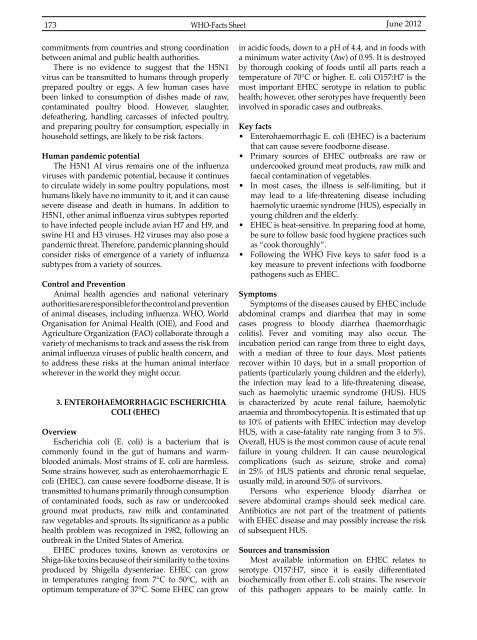Vol 44 # 2 June 2012 - Kma.org.kw
Vol 44 # 2 June 2012 - Kma.org.kw
Vol 44 # 2 June 2012 - Kma.org.kw
You also want an ePaper? Increase the reach of your titles
YUMPU automatically turns print PDFs into web optimized ePapers that Google loves.
173<br />
WHO-Facts Sheet <strong>June</strong> <strong>2012</strong><br />
commitments from countries and strong coordination<br />
between animal and public health authorities.<br />
There is no evidence to suggest that the H5N1<br />
virus can be transmitted to humans through properly<br />
prepared poultry or eggs. A few human cases have<br />
been linked to consumption of dishes made of raw,<br />
contaminated poultry blood. However, slaughter,<br />
defeathering, handling carcasses of infected poultry,<br />
and preparing poultry for consumption, especially in<br />
household settings, are likely to be risk factors.<br />
Human pandemic potential<br />
The H5N1 AI virus remains one of the influenza<br />
viruses with pandemic potential, because it continues<br />
to circulate widely in some poultry populations, most<br />
humans likely have no immunity to it, and it can cause<br />
severe disease and death in humans. In addition to<br />
H5N1, other animal influenza virus subtypes reported<br />
to have infected people include avian H7 and H9, and<br />
swine H1 and H3 viruses. H2 viruses may also pose a<br />
pandemic threat. Therefore, pandemic planning should<br />
consider risks of emergence of a variety of influenza<br />
subtypes from a variety of sources.<br />
Control and Prevention<br />
Animal health agencies and national veterinary<br />
authorities are responsible for the control and prevention<br />
of animal diseases, including influenza. WHO, World<br />
Organisation for Animal Health (OIE), and Food and<br />
Agriculture Organization (FAO) collaborate through a<br />
variety of mechanisms to track and assess the risk from<br />
animal influenza viruses of public health concern, and<br />
to address these risks at the human animal interface<br />
wherever in the world they might occur.<br />
3. ENTEROHAEMORRHAGIC ESCHERICHIA<br />
COLI (EHEC)<br />
Overview<br />
Escherichia coli (E. coli) is a bacterium that is<br />
commonly found in the gut of humans and warmblooded<br />
animals. Most strains of E. coli are harmless.<br />
Some strains however, such as enterohaemorrhagic E.<br />
coli (EHEC), can cause severe foodborne disease. It is<br />
transmitted to humans primarily through consumption<br />
of contaminated foods, such as raw or undercooked<br />
ground meat products, raw milk and contaminated<br />
raw vegetables and sprouts. Its significance as a public<br />
health problem was recognized in 1982, following an<br />
outbreak in the United States of America.<br />
EHEC produces toxins, known as verotoxins or<br />
Shiga-like toxins because of their similarity to the toxins<br />
produced by Shigella dysenteriae. EHEC can grow<br />
in temperatures ranging from 7°C to 50°C, with an<br />
optimum temperature of 37°C. Some EHEC can grow<br />
in acidic foods, down to a pH of 4.4, and in foods with<br />
a minimum water activity (Aw) of 0.95. It is destroyed<br />
by thorough cooking of foods until all parts reach a<br />
temperature of 70°C or higher. E. coli O157:H7 is the<br />
most important EHEC serotype in relation to public<br />
health; however, other serotypes have frequently been<br />
involved in sporadic cases and outbreaks.<br />
Key facts<br />
• Enterohaemorrhagic E. coli (EHEC) is a bacterium<br />
that can cause severe foodborne disease.<br />
• Primary sources of EHEC outbreaks are raw or<br />
undercooked ground meat products, raw milk and<br />
faecal contamination of vegetables.<br />
• In most cases, the illness is self-limiting, but it<br />
may lead to a life-threatening disease including<br />
haemolytic uraemic syndrome (HUS), especially in<br />
young children and the elderly.<br />
• EHEC is heat-sensitive. In preparing food at home,<br />
be sure to follow basic food hygiene practices such<br />
as “cook thoroughly”.<br />
• Following the WHO Five keys to safer food is a<br />
key measure to prevent infections with foodborne<br />
pathogens such as EHEC.<br />
Symptoms<br />
Symptoms of the diseases caused by EHEC include<br />
abdominal cramps and diarrhea that may in some<br />
cases progress to bloody diarrhea (haemorrhagic<br />
colitis). Fever and vomiting may also occur. The<br />
incubation period can range from three to eight days,<br />
with a median of three to four days. Most patients<br />
recover within 10 days, but in a small proportion of<br />
patients (particularly young children and the elderly),<br />
the infection may lead to a life-threatening disease,<br />
such as haemolytic uraemic syndrome (HUS). HUS<br />
is characterized by acute renal failure, haemolytic<br />
anaemia and thrombocytopenia. It is estimated that up<br />
to 10% of patients with EHEC infection may develop<br />
HUS, with a case-fatality rate ranging from 3 to 5%.<br />
Overall, HUS is the most common cause of acute renal<br />
failure in young children. It can cause neurological<br />
complications (such as seizure, stroke and coma)<br />
in 25% of HUS patients and chronic renal sequelae,<br />
usually mild, in around 50% of survivors.<br />
Persons who experience bloody diarrhea or<br />
severe abdominal cramps should seek medical care.<br />
Antibiotics are not part of the treatment of patients<br />
with EHEC disease and may possibly increase the risk<br />
of subsequent HUS.<br />
Sources and transmission<br />
Most available information on EHEC relates to<br />
serotype O157:H7, since it is easily differentiated<br />
biochemically from other E. coli strains. The reservoir<br />
of this pathogen appears to be mainly cattle. In
















